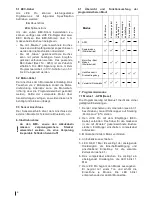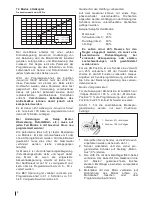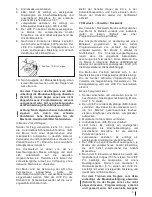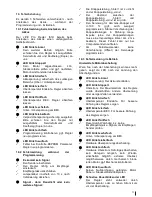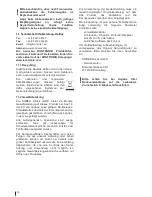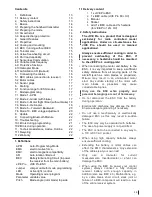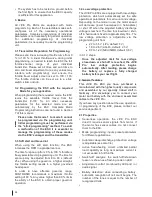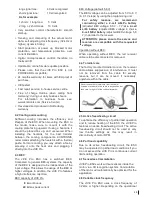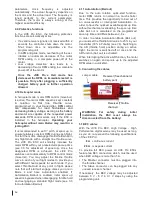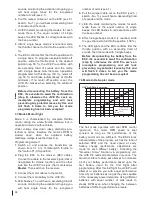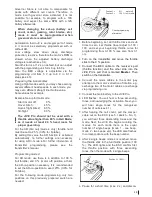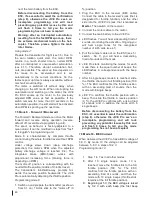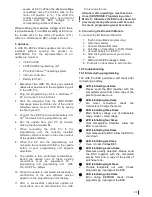
20
nect the main battery
from the ESC.
Before disconnecting the battery from
the
ESC, it's essential to await the
confirmation
(step 8), otherwise the JIVE Pro see's an
incomplete programming and will lock
preventing any potential issues by this and
will flash 9 times to tell you the mode
programming has not been accepted
!
Warning: after an interrupted autorotation,
resulting from the fast RPM spool-up, there
are extreme mechanical loads on the
heli-
copter. Therefore please tighten the main
rotor blades.
Using mode 4
:
Prepare the transmitter for flight
(see 3.5). Due to
the auto rotation quick start, the
motor RPM
returns in a much shorter time to n
ormal RPM
after an interrupted or unsuccessful
autorotation
(see 4.11). Therefore, abrupt autorotation bail
outs are possible. The spool up time depends on
the mass to
be accelerated and is set
automatically to
the current conditions. So the
fastest spool up time is always available, without
mechanical overloading.
The motor is switched off without delay,
when
changing to the AR mode. When
interrupting the
autorotation and switching on the
motor, the JIVE
Pro ESC spools up the motor to
the previously
adjusted RPM value as fast as
possible. If the
switch remains for more than 90 seconds in the
autorotation position,
the soft start will be activated,
when RPM is spooling up the next
time.
7.5 Mode 6 - Forward / Backward
The Forward / Backward mode can drive the Motor
forward and reverse during operation (reverse,
default: off, reversible via programming unit).
The spool up behavior is factory-adjusted to a
mean value. It can be modified in steps from "fast"
to "sluggish" via programming unit.
Mode 6 is characterized by complete
throttle
control during the whole throttle travel
without RPM
control.
Under voltage slows down
(deep discharge
protection) the motor’s RPM when the adjusted
battery discharge voltage is reached
(3.4). The
integrated
brake
(EMK-brake)
works
with
proportional increasing force (braking force is
depending on RPM).
The motor-off position is corresponding
with the
neutral throttle position
(middle of throttle travel).
The transmitter’s
full-throttle-way prompts for-
wards, the reverse position backwards. The JIVE
Pro is automatically detecting the throttle position.
Programming mode 6
:
1.
Switch on and prepare the transmitter (as shown
from 3.1 on). Throttle stick to the "motor off" (0
%) position.
1.
Plug the ESC to the receiver
(BEC cable).
Connect the cable to the receiver’s jack
(that is
designated for throttle
function) and the other
side into the JIVE Pro’s jack, that is marked as
Master
. Then switch on the receiver.
2.
Connect the motor cables to the
motor.
3.
Connect the main battery to the
JIVE Pro.
4.
LED
flashes. You will hear a ascending triad of
sounds,
monitoring the activation. Ongoing you
will hear single
tones for the recognised
number of LiPo
cells (see 4.1).
5.
Pull the Jumper cable out on
the ESC (see 5 /
sketch - No.
7), you will hear a descending
triad of sounds and the
mode
6.
JIVE Pro starts monitoring the modes,
for each
mode there is the equal number of beeps, the
LED
flashes in correspondence with the beep
number.
7.
After 6 single beeps mode 6 is
reached, slide
the throttle channel to full throttle
position (100
%). The ESC confirms first the throttle position
with an ascending triad of sounds, then the
mode with 6 single beeps.
8.
JIVE Pro confirms the throttle position with a
beep. Then slide the throttle in reverse
position
(0 %), the JIVE Pro confirms with a rising triad
of sounds and in addition the mode
with 6
single
beeps.
Before disconnecting the battery from
the
ESC, it's essential to await the
confirmation
(step 8), otherwise the JIVE Pro see's an
incomplete programming and will lock
preventing any potential issues by this and
will flash 9 times to tell you the mode
programming has not been accepted
!
7.6
Mode 10 - BEC Current
When delivered the JIVE Pro has a BEC voltage of
5.6 V. By mode 10 the voltage can be adjusted
between 5 - 8 V in steps of 0.2 V.
Programming mode 10
:
1. Step 1 to 7 as in all other modes
8.
After 10 single beeps, mode 10 is
reached; move the throttle stick to the full
throttle
position (100 %). The ESC
confirms first the throttle position with an
ascending triad of sounds, and then the
mode with 10 single beeps (throttle stick
remains at the full throttle position).
9. Beginning at 5 V, the BEC voltage is raised
by 0.2 V with each beep (the first beep
!
!
!

